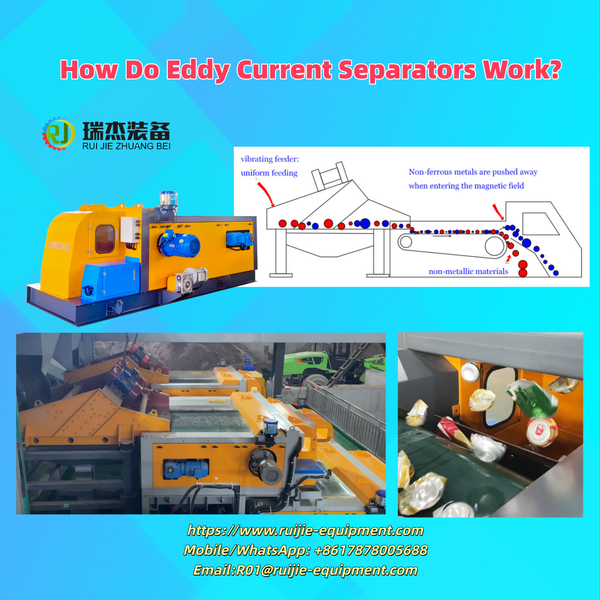Eddy current separators are essential devices in recycling and industrial sorting, designed to separate non-ferrous metals from mixed materials. To fully grasp their role, we break down their definition, working principle, real-world uses, and Ruijie’s specialized models.
What Is an Eddy Current Separator?
An eddy current separator is a mechanical-electromagnetic device that sorts conductive non-ferrous metals (e.g., aluminum, copper, zinc) from non-conductive materials (e.g., plastic, glass, wood). It leverages the “eddy current effect”—a physical phenomenon—to create a repulsive force, enabling automatic, high-precision separation. Unlike manual sorting, this equipment handles large material volumes efficiently, making it a cornerstone of modern recycling lines.
How Do Eddy Current Separators Work
The eddy current separator working principle follows three simple, continuous steps:
- First, mixed materials (e.g., waste with metal scrap) are fed onto a conveyor belt, which moves them toward a rotating magnetic drum. This drum has permanent magnets arranged in a circular pattern, generating a fast-changing magnetic field as it spins.
- Second, when conductive non-ferrous metals pass through the magnetic field, eddy currents (circular electric currents) are induced in the metals. By Lenz’s Law, these eddy currents produce their own magnetic field—opposing the drum’s field.
- Third, the opposing magnetic force repels the non-ferrous metals, pushing them off the conveyor into a dedicated collection bin. Non-conductive materials, unaffected by the magnetic field, continue along the belt to another bin. This process achieves over 95% separation accuracy, a key advantage of the eddy current separator.
The Application of Eddy Current Separators
Eddy current separators are widely used across industries for non-ferrous metal sorting:
- Waste recycling: They extract aluminum cans, copper wires, and zinc parts from municipal solid waste (MSW) and construction waste, turning trash into reusable resources.
- Scrap yards: They separate valuable non-ferrous metals from mixed scrap, boosting recyclers’ profits by ensuring no high-value materials are wasted.
- E-waste processing: They recover copper from old circuit boards and aluminum from electronic casings, supporting eco-friendly disposal of electronic waste.
- Mining: They separate non-ferrous metal ores like copper ore from useless gangue, improving ore purity for further processing.
Types of Ruijie Eddy Current Separators
Ruijie offers diverse eddy current separator models to fit different industry needs:
- Standard Eddy Current Separators: For general recycling, with adjustable conveyor speed and magnetic strength to handle most non-ferrous sorting tasks.
- High-Speed Models: Built for large scrap yards, with faster drum rotation to process high material volumes quickly.
- Single/dual-layer: Optional layers, the dual-layer eddy current separator saves horizontal space, perfect for projects with limited site area, while handling large material volumes.
- Customized Solutions: Bespoke designs,like wider belts and specialized magnets, to match clients’ unique sorting requirements.
In short, the eddy current separator simplifies complex metal sorting via its smart working principle. Ruijie’s tailored models further make it a reliable choice for efficient, sustainable non-ferrous metal separation.
https://www.ruijie-equipment.com
Mobile/WhatsApp: +8617878005688
Email:R01@ruijie-equipment.com

